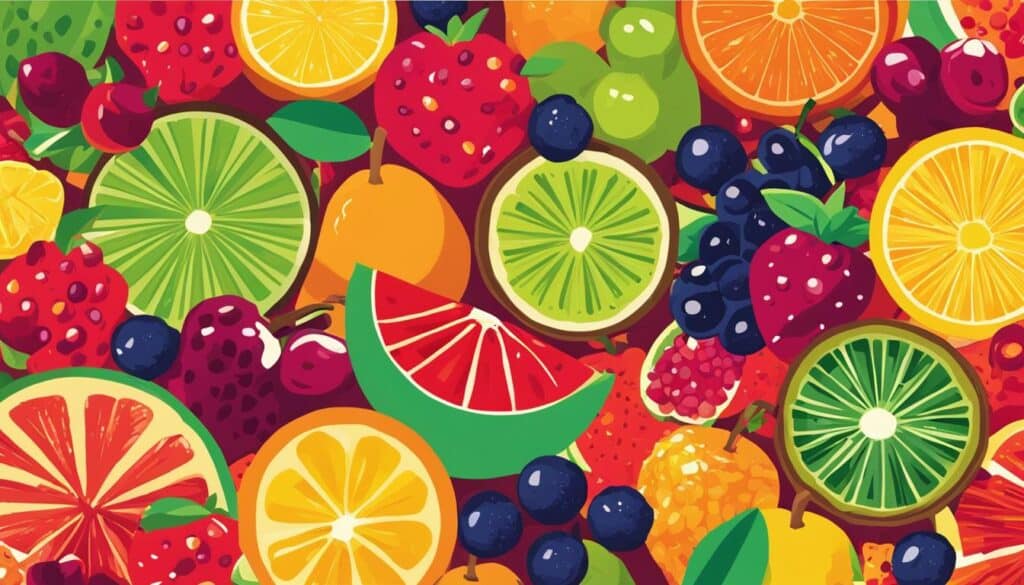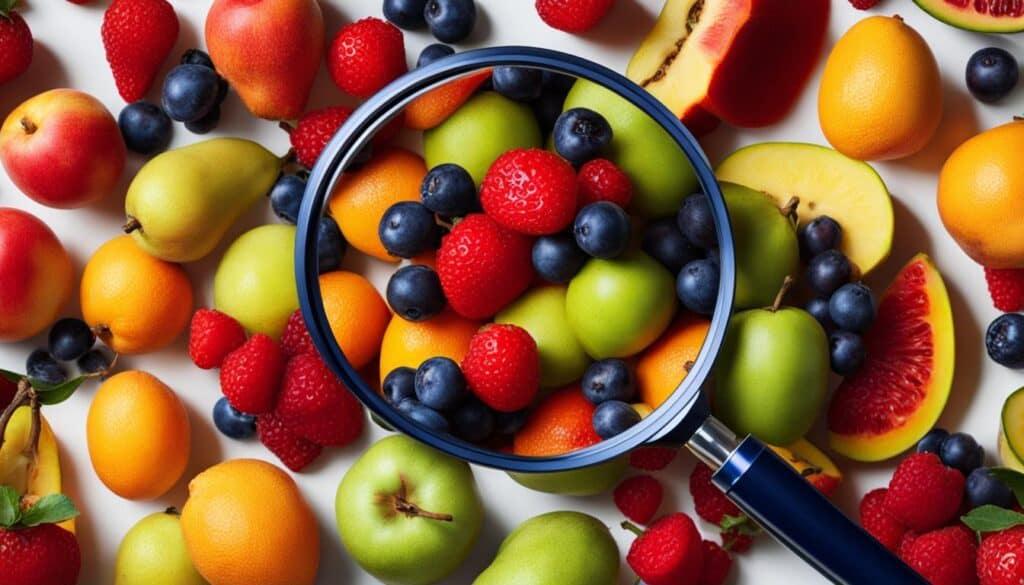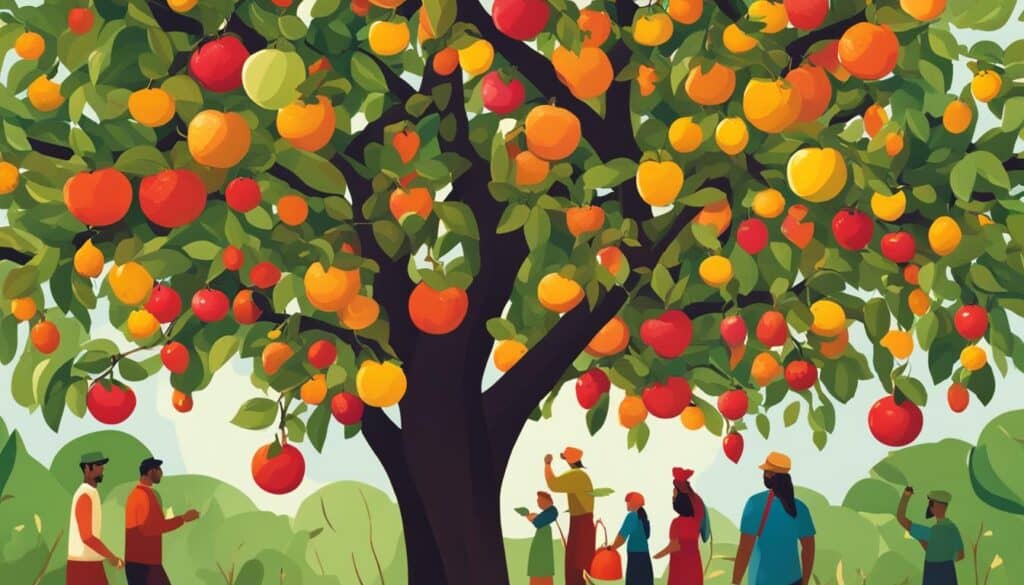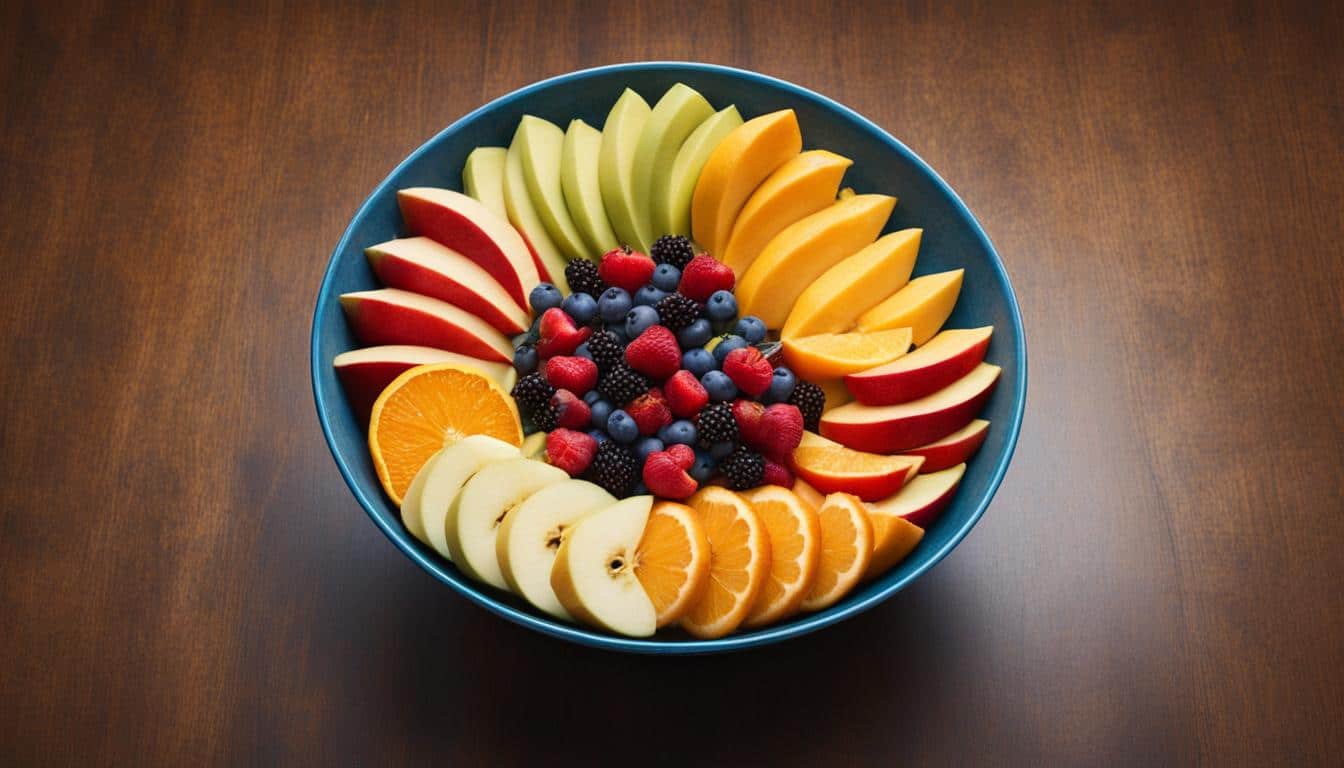Fruits and vegetables may seem like simple terms, but the grammatical nuances between fruit and fruits can cause confusion. Understanding the proper usage of these terms is crucial for clear communication in English.
In botanical terms, fruit refers to the mature ovary of a flowering plant that usually contains seeds. Vegetable is a general term for plant parts consumed as food that are not classified as fruits. However, in everyday language, there is often a discrepancy between culinary definitions and scientific classifications.
Key Takeaways:
- The plural form of fruit is fruits when referring to multiple types or varieties of fruit.
- The singular form of fruits is fruit when referring to a single type or variety.
- Understanding the grammar rules and proper usage of fruit and fruits is essential for clear communication in English.
- Paying attention to context and intended meaning helps avoid common mistakes with fruit and fruits.
- Mastering the use of fruit and fruits can enhance language skills and improve overall communication abilities.
The Definition and Usage of Fruit and Fruits
In botanical terms, fruit refers to the mature ovary of a flowering plant that usually contains seeds. It is the edible part that develops from the flower, and it plays a significant role in plant reproduction. On the other hand, a vegetable is a general term used for plant parts consumed as food that are not classified as fruits. While this botanical definition provides us with a clear distinction between fruit and vegetable, it is essential to note that in everyday language, there is often a discrepancy between culinary definitions and scientific classifications.
In everyday conversation, the term fruit is commonly used to describe a wide variety of sweet or savory edible plant products that are typically consumed as a snack or dessert. This includes apples, oranges, berries, melons, and many others. Fruits are generally characterized by their distinct flavors, vibrant colors, and ability to be consumed fresh or used in various culinary applications such as juices, pies, salads, and jams.
On the other hand, the term fruits can be used to refer to multiple types or varieties of fruit. For example, we can say “I bought different fruits at the grocery store,” indicating that we purchased a variety of fruits like apples, bananas, and oranges. In this context, the plural form is used to represent the different kinds of fruit that were obtained.
To illustrate the usage and distinction between fruit and fruits, consider the following examples:
“I love eating fruit for breakfast.”
“I bought different types of fruits at the market.”
It’s important to remember that the correct usage of fruit and fruits depends on the specific context and the intended meaning. In botanical terms, fruit is a specific structure that develops from a flower, while in everyday language, fruit is a broader term used to refer to a wide range of edible plant products. The plural form fruits is used to indicate multiple types or varieties of fruit.
The Plural Form of Fruit
When it comes to discussing multiple types or varieties of fruit, it’s important to use the plural form: fruits. For example, you can say “I bought different fruits at the grocery store.” This allows you to convey that you purchased various kinds of fruit.
However, there are certain contexts where it is more grammatically accurate to use the singular form of fruit, even when referring to a quantity of uncountable nouns. For instance, instead of saying “some fruits,” it is preferable to say “some fruit.” This usage preserves the non-countable nature of the noun while still indicating an indeterminate amount.
“I bought a basket of fruit at the market.”
Using the appropriate plural form, fruits, allows for clearer communication when discussing a range of specific fruit types. It ensures that your meaning is accurately conveyed and eliminates the potential for confusion.
Uses of Fruit in Plural
To help illustrate the correct usage, consider the following examples:
- “I love eating fruits like apples, bananas, and oranges.”
- “She is knowledgeable about tropical fruits such as mangoes and papayas.”
These examples show how the plural form of fruit, fruits, allows you to express a variety of specific fruit types in a clear and concise manner.
The Singular Form of Fruits
The singular form of fruits is fruit. It is used when referring to a single type or variety of fruit. For example, you would say “I ate a delicious fruit for breakfast.” In this context, the word fruit is used to describe one specific fruit.
When discussing multiple types or varieties of fruit, it is important to use the plural form, fruits. For instance, you would say “I bought different fruits at the grocery store.” This highlights that you purchased various types of fruit, rather than just one specific fruit.
The distinction between the singular form, fruit, and the plural form, fruits, allows for clear communication and avoids confusion. By using the appropriate form, you can effectively convey your intended meaning and enhance your language skills.
By understanding when to use fruit instead of fruits and utilizing fruits in their singular form, you can communicate more accurately and effectively. An incorrect usage of fruit and fruits can lead to confusion and misinterpretation. Therefore, it is important to master the proper grammar rules surrounding the singular and plural forms of these terms.
Grammar Rules for Using Fruit and Fruits
When it comes to using the words “fruit” and “fruits” correctly, it’s important to consider the specific context and intended meaning. Let’s explore the grammar rules that govern the usage of these terms.
Fruit as a Non-Countable Noun:
Generally, the word “fruit” is used as a non-countable noun when referring to the concept of fruit as a whole or when discussing a specific type or variety of fruit.
“I enjoy eating fruit with my breakfast.”
“Mango is my favorite fruit.”
Fruits as a Countable Noun:
On the other hand, the word “fruits” is used as a countable noun when talking about multiple types or varieties of fruit.
“I bought several fruits at the grocery store.”
“The fruits in the basket are delicious.”
By following these grammar rules, we ensure clarity and precision in our communication. Understanding when to use “fruit” or “fruits” can help us convey our intended meaning effectively.
Example:
| Fruit | Fruits |
|---|---|
| Apple | Apples |
| Orange | Oranges |
| Pineapple | Pineapples |

Common Mistakes with Fruit and Fruits
When it comes to using the words “fruit” and “fruits,” there are some common mistakes that people often make. These mistakes can lead to confusion and misunderstandings in communication. It’s important to be aware of these errors and avoid them to ensure clear and accurate expression.
Mistake 1: Using “Fruits” inappropriately
One common mistake is using the plural form “fruits” when discussing a general concept or a specific type of fruit. For example, saying “I love fruits” when referring to various types of fruit is incorrect. The correct usage would be “I love fruit.” The word “fruit” is already a plural noun, which encompasses the idea of multiple types or varieties of fruit.
Using “fruits” as the plural form in these contexts goes against grammatical rules and can sound awkward or incorrect to native English speakers.
Mistake 2: Using “Fruit” inappropriately
On the other hand, another mistake is using the singular form “fruit” when talking about multiple types or varieties. For instance, saying “I bought different fruit at the grocery store” instead of “I bought different fruits” is incorrect. The plural form “fruits” should be used when talking about more than one type or variety of fruit.
Using “fruit” in the singular form when pluralization is necessary can cause confusion and may give the impression that only one type of fruit was involved.
It’s crucial to pay attention to the context and intended meaning when choosing between “fruit” and “fruits.” This will help you avoid these common mistakes and ensure that your communication is accurate and clear.
Take a look at the example below to further illustrate the correct usage:
I brought some fruit for the picnic.”
Correct.
“I brought some fruits for the picnic.”
Incorrect.
Remember, understanding the proper usage of “fruit” and “fruits” is essential for effective communication in English.

| Error | Correction |
|---|---|
| Using “fruits” when discussing a general concept or a specific type of fruit | Using “fruit” (plural noun) instead |
| Using “fruit” when talking about multiple types or varieties | Using “fruits” (plural noun) instead |
The Culinary vs. Scientific Classification of Fruits and Vegetables
When it comes to classifying fruits and vegetables, there can be a significant difference between culinary and scientific classifications. The culinary classification is based on taste and usage in recipes, while the scientific classification is rooted in the botanical definitions of fruit and vegetable. This disparity often leads to confusion and debates about what exactly qualifies as a fruit or a vegetable.
In culinary terms, fruits are typically characterized by their sweet or savory taste and are used in both sweet and savory dishes. They are often enjoyed as a standalone snack or incorporated into desserts, salads, or jams. Vegetables, on the other hand, are usually savory and are commonly used in salads, side dishes, soups, and stews. However, it’s important to note that there are exceptions to these generalizations, especially when it comes to fruits like tomatoes and avocados that are often used in savory dishes.
In contrast, the scientific classification of fruits and vegetables is based on the botanical definitions. In botanical terms, fruits are the mature ovaries of flowering plants that contain seeds. This means that anything that develops from a flower and contains seeds is technically a fruit, including tomatoes, cucumbers, and even nuts. Vegetables, on the other hand, encompass all other parts of the plant that are consumed as food, such as leaves, stems, and roots.
The discrepancy between the culinary and scientific classifications can lead to some interesting categorizations. For example, in culinary terms, a tomato is often considered a vegetable and used in savory dishes like salads and sandwiches. However, from a botanical standpoint, a tomato is technically a fruit because it develops from the ovary of a flowering plant and contains seeds.
Examples of Culinary vs. Scientific Classification
| Culinary Classification | Scientific Classification |
|---|---|
| Tomato (used in savory dishes) | Fruit |
| Cucumber (used in salads) | Fruit |
| Avocado (used in guacamole) | Fruit |
| Carrot (used in stews) | Vegetable |
| Spinach (used in salads) | Vegetable |
Understanding the difference between the culinary and scientific classifications of fruits and vegetables can help clarify some of the confusion surrounding these terms. While culinary classifications are based on taste and usage in recipes, scientific classifications are rooted in botanical definitions. It’s important to consider both perspectives when discussing fruits and vegetables to ensure accurate communication.
Language and Cultural Influences on the Usage of Fruit and Fruits
The usage of fruit and fruits can vary across different languages and cultures. Cultural practices and traditions play a significant role in shaping how these terms are used and understood. It is fascinating to explore how language and culture intertwine to influence the usage of fruit and fruits.
In certain cuisines, cultural factors can lead to a classification that differs from the botanical or scientific definition of fruit. For instance, avocados and tomatoes, which are technically classified as fruits, are often considered and used as vegetables in certain culinary traditions. This cultural distinction affects how these foods are perceived and incorporated into recipes.

The classification of avocados and tomatoes as vegetables in certain cuisines showcases the impact of cultural factors on the usage of fruit and fruits. It highlights how language and local practices shape our understanding of these terms and influence the ways in which they are used in different cultural contexts.
Furthermore, language itself can reflect cultural influences on fruit and fruit usage. Certain languages may have specific terms or expressions for different types of fruits that reflect the cultural significance or culinary traditions associated with them. The diversity of languages and cultural practices around the world adds depth and richness to our understanding and appreciation of fruit and fruits.
Language and culture are inseparably intertwined, and they both contribute to our perception and usage of fruit and fruits. By exploring the language and cultural influences on fruit and fruit usage, we can gain a deeper appreciation for the diversity and complexity of the world around us.
The Evolution of Language and the Usage of Fruit and Fruits
Language is a dynamic system that evolves over time, influenced by cultural practices, societal changes, and the everyday usage by native speakers. The usage of words like “fruit” and “fruits” reflects the changing nature of language and how it adapts to the needs of its users.
In the evolution of language, words can take on different meanings, or their usage can shift over time. Similarly, the usage of “fruit” and “fruits” has evolved and can vary depending on the context or cultural factors. While grammar rules provide guidelines for clear communication, they are not always set in stone and can be influenced by cultural and linguistic shifts.
The evolution of language is a fascinating process that impacts various aspects of communication. In the case of “fruit” and “fruits,” the changes in their usage can be attributed to several factors:
- Cultural Influences: Cultural practices and traditions play a significant role in shaping language. Different cultures may have distinct interpretations of what constitutes a fruit, leading to variations in the usage of the terms “fruit” and “fruits.” For example, certain cuisines may classify items like avocados or tomatoes as vegetables, while botanically they are classified as fruits. This cultural diversity contributes to the evolving language and usage patterns.
- Language Development: Language develops organically through everyday usage, with words and phrases taking on new meanings or undergoing semantic shifts. The usage of “fruit” and “fruits” might change over time as people adopt new linguistic patterns or adapt words to fit their communication needs. For instance, in some contexts, both “fruit” and “fruits” can be used interchangeably to refer to multiple types or varieties of fruit, highlighting the fluidity of language evolution.
- Contextual Adaptation: Language is highly context-dependent, and the usage of “fruit” and “fruits” can vary based on the specific context. People adapt their language to convey their intended meaning effectively, even if it deviates from traditional grammar rules. This contextual adaptation contributes to the changing landscape of language and the flexible usage of terms like “fruit” and “fruits.”
The evolution of language and the usage of words like “fruit” and “fruits” highlight the dynamic nature of linguistic communication. While adhering to grammar rules is essential for effective communication, it is equally important to recognize and embrace the evolving nature of language. Language adapts to the needs of its users, incorporating cultural influences and everyday usage patterns.
Adaptation and evolution are natural processes that shape language, allowing it to remain relevant and effective in a changing world.
| Factors Influencing the Usage of Fruit and Fruits | Examples |
|---|---|
| Cultural Influences | Different culinary classifications of fruits across cultures |
| Language Development | Changes in linguistic patterns and semantic shifts |
| Contextual Adaptation | Adapting language to convey specific meaning effectively |
Table: Factors influencing the usage of “fruit” and “fruits” and their respective examples.
The Power of Vocabulary – Mastering the Use of Fruit and Fruits
Mastering the use of fruit and fruits is a crucial component of developing strong English language skills. By understanding the nuances and correct usage of these terms, you can significantly improve your grammar and communication abilities.
Improving your English grammar skills involves not only knowing the words to use but also understanding when and how to use them effectively. Fruit and fruits, despite their seemingly simple difference, carry significant grammatical implications.
The power of vocabulary lies in its ability to convey precise meaning and create clear communication. When you master the use of fruit and fruits, you gain the confidence to express your thoughts accurately and fluently.
Enhancing your language skills requires practice and exposure to different examples. By engaging in conversations, reading various texts, and exploring different contexts, you can refine your understanding and usage of fruit and fruits.
The Role of Context
Understanding the correct usage of fruit and fruits relies heavily on contextual factors. The context determines whether you should use the singular form “fruit” or the plural form “fruits.”
For instance, when referring to a single type or variety of fruit, such as “I ate a delicious fruit for breakfast,” it is appropriate to use the singular form. On the other hand, when discussing multiple types or varieties of fruit, like “I bought different fruits at the grocery store,” the plural form is more suitable.
Mastering the power of vocabulary involves recognizing these subtle differences and applying them appropriately in various situations.
Clarity in Communication
You may wonder why it is crucial to master the use of fruit and fruits when communicating in English. The answer lies in the potential confusion that may arise from inaccurate usage. Using the wrong form can alter the intended meaning of your message and lead to misunderstandings.
By honing your skills in using fruit and fruits with precision, you ensure clear and effective communication, leaving no room for ambiguity.
Whether you are writing an essay, having a conversation, or giving a presentation, the mastery of language helps you convey your thoughts accurately, garnering attention and understanding from your audience.
Improvement through Practice
To improve your English grammar skills, practice plays an integral role. Engage in activities such as:
- Writing exercises: Create sentences and paragraphs that incorporate fruit and fruits in different contexts.
- Conversation practice: Engage in discussions where you can apply the correct usage of fruit and fruits.
- Reading materials: Explore various texts to expand your vocabulary and reinforce your understanding of grammar rules.
Remember, language learning is a continuous process, and consistent practice will yield significant improvements in your mastery of fruit and fruits.
Now that you understand the power of vocabulary and its impact on English grammar skills, it’s time to embark on your journey towards mastering the use of fruit and fruits.
Avocado – A Case Study in Plural Form
Let’s take a closer look at avocados, a delicious and versatile fruit that serves as a perfect case study for understanding the plural form. The plural of avocado is avocados, following the standard rule of adding an -s to the end of the singular noun.
Avocado is an example of a regular plural noun, where the formation of plurals follows a consistent pattern. Regular plurals are formed by simply adding -s or -es to the end of the singular noun, such as apples, bananas, or oranges.
In the case of avocados, the singular form is avocado, and when we want to refer to multiple avocados, we use the plural form avocados. For example: “I bought three avocados from the grocery store to make guacamole.”
Understanding the difference between regular and irregular plurals can help us navigate the complexities of English grammar. While regular plurals follow consistent rules, irregular plurals have unique formations, making them more challenging to learn and remember.
Avocado’s regular plural form provides a straightforward example of creating plurals in English. By mastering the rules for regular plurals like avocados, we can expand our vocabulary and communicate more effectively.
Conclusion: Understanding the Grammar Rules and Usage of Fruit and Fruits
In conclusion, the distinction between fruit and fruits holds significant grammatical implications in the English language. It is crucial to grasp the appropriate usage of these terms to ensure clear communication. By paying close attention to context and intended meaning, one can avoid common errors associated with these words.
Mastering the use of fruit and fruits is a valuable skill that can enhance language proficiency and overall communication abilities. An understanding of the grammar rules enables individuals to express themselves more effectively, and by practicing and familiarizing oneself with different examples, one can confidently navigate the usage of these terms.
In summary, the correct usage of fruit and fruits depends on the specific context. Fruit is used as a non-countable noun when referring to the concept as a whole or discussing a specific type or variety. On the other hand, fruits is used as a countable noun when referring to multiple types or varieties. By adhering to these guidelines, individuals can improve their English grammar skills and communicate more accurately.
FAQ
Why do we say “fruit” and not “fruits”?
The usage of “fruit” and “fruits” depends on the specific context and intended meaning. “Fruit” is used as a non-countable noun when referring to the concept of fruit as a whole or discussing a specific type or variety of fruit. “Fruits” is used as a countable noun when talking about multiple types or varieties of fruit.
What is the difference between “fruit” and “fruits”?
In botanical terms, “fruit” refers to the mature ovary of a flowering plant, while “vegetable” is a general term for plant parts consumed as food. However, in everyday language, there can be a discrepancy between culinary definitions and scientific classifications.
What is the plural form of “fruit”?
The plural form of “fruit” is “fruits.” It is used when referring to multiple types or varieties of fruit, such as “I bought different fruits at the grocery store.”
What is the singular form of “fruits”?
The singular form of “fruits” is “fruit.” It is used when referring to a single type or variety of fruit, such as “I ate a delicious fruit for breakfast.”
What are the grammar rules for using “fruit” and “fruits”?
“Fruit” is used as a non-countable noun when discussing the concept of fruit or a specific type of fruit. “Fruits” is used as a countable noun when discussing multiple types or varieties of fruit.
What are some common mistakes with “fruit” and “fruits”?
One common mistake is using the plural form “fruits” when discussing a general concept or a specific type of fruit. Another mistake is using the singular form “fruit” when talking about multiple types or varieties. It is important to pay attention to the context and intended meaning to avoid these common errors.
What is the distinction between the culinary and scientific classification of fruits and vegetables?
The culinary classification is based on taste and usage in recipes, while the scientific classification is based on the botanical definitions of fruit and vegetable. This discrepancy between culinary and scientific classifications can cause confusion.
How do language and culture influence the usage of “fruit” and “fruits”?
Language and cultural practices can influence how these terms are used and understood. For example, certain cuisines may classify avocados or tomatoes as vegetables, even though they are botanically classified as fruits.
How does the evolution of language affect the usage of “fruit” and “fruits”?
Language evolves over time, and the usage of “fruit” and “fruits” reflects these changes. While grammar rules provide guidelines, language can be influenced by cultural and linguistic shifts.
How can I master the use of “fruit” and “fruits”?
Understanding the nuances and correct usage of “fruit” and “fruits” is essential for clear communication. Practice and exposure to different examples will help in mastering the use of these terms.
What is the plural form of “avocado”?
The plural form of “avocado” is “avocados.” It follows the regular plural noun rule of adding an -s to the end of the singular noun.
What is the conclusion about “fruit” and “fruits”?
Understanding the grammar rules and proper usage of “fruit” and “fruits” is essential for clear communication. The distinction between “fruit” and “fruits” carries significant grammatical implications, and it is important to pay attention to context and intended meaning when using these terms.





Leave a Reply